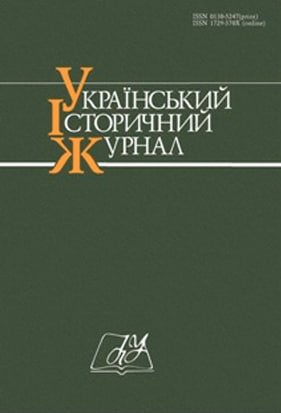Volodymyr’s Baptism and Hagiography: Between Legend and Historiography
DOI:
https://doi.org/10.15407/uhj2025.02.005Keywords:
baptism, ordeal, Last Judgement, Prince Volodymyr, conversion, Church service, paganism, MenaionAbstract
Aim — this article examines three aspects of the baptism of Volodymyr and the celebration of his holiness as reflected in medieval texts: the influence of ordeal rituals on Pietro Damiani’s narrative of the baptism of the Rus’ and their leader; a fragment of the story of Volodymyr’s conversion in the Tale of Bygone Years, focusing on the depiction of the Last Judgement specifically; the creation and dissemination of various sermons and worship services honoring Prince Volodymyr as a saint. The research is based on chronicle texts, hagiographies, and iconographic images.
Methods. The study employs various research methods, including comparative textual criticism, retrospective analysis, and archival heuristics.
Scientific novelty. This article revises several descriptions of Prince Volodymyr’s conversion and commemoration. A section of the Philosopher’s Speech in the Tale of Bygone Years, focusing on the Last Judgement, draws from two sources: the fragments of the Aprakos Gospel, which relate to Shrovetide and Cheesfare Weeks, the period during which the catechumenates began the preparation for baptism. The article also explores Byzantine iconography of the Last Judgement, which developed between the tenth and twelfth centuries and influenced Kyiv. The ecclesiastical commemoration of Volodymyr, which dates back to the mid-thirteenth century, was initially reflected in the sermon preserved in the Bulgarian manuscript.
Conclusions. Sources from different cultural contexts interpreted the baptism of the Rus’ in various ways. Byzantine chronicles describe the baptism as a miraculous event involving the Holy Scriptures. However, the Byzantine account of Volodymyr’s baptism presents a detailed catechetical narrative instead of focusing on a visible miracle. The Philosopher’s Speech aligns with other conversion narratives, such as those of Barlaam and Joasaph and Bulgarian ruler Boris (Mihail), particularly in its depiction of the Last Judgement. This description is based on fragments from the Gospel of Aprakos. In Latin sources, the depiction of the Rus’ baptism appears to follow the standards of the old law of the ordeal. Volodymyr’s recognition as a saint dates to the thirteenth century, reflecting the activities of Prince Danylo Romanovych. Two sources document this recognition: one is inscribed in the Chronicle of Halych-Volyn, and the other is in the Sinai Palimpsest. Volodymyr’s hagiography largely repeats or summarizes the chronicle, omitting most catechetical phrases and quotations. However, the author kept the motif of paganism and the conflict with it. In this way, the new realities of the Rurikids’ “family state” were reflected, and the nomads were portrayed as pagans.


